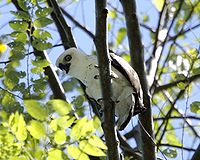Sulawesi Hawk-Eagle
 From Conservapedia
From Conservapedia | Sulawesi Hawk-eagle | |
|---|---|

| |
| Scientific classification | |
| Kingdom Information | |
| Domain | Eukaryota |
| Kingdom | Animalia |
| Subkingdom | Bilateria |
| Branch | Deuterostomia |
| Phylum Information | |
| Phylum | Chordata |
| Sub-phylum | Vertebrata |
| Infraphylum | Gnathostomata |
| Class Information | |
| Superclass | Tetrapoda |
| Class | Aves |
| Sub-class | Neornithes |
| Infra-class | Neoaves |
| Order Information | |
| Order | Accipitriformes |
| Sub-order | Accipitres |
| Family Information | |
| Superfamily | Accipitroidea |
| Family | Accipitridae |
| Sub-family | Buteoninae |
| Genus Information | |
| Genus | Nisaetus |
| Species Information | |
| Species | N. lanceolatus |
| Synonyms | Spizaetus lanceolatus |
| Population statistics | |
| Population | 670-6,700 (2016 est.)[1] |
| Conservation status | Least concern[2] |
The Sulawesi hawk-eagle (Nisaetus lanceolatus) is a bird of prey of the family Accipitridae, and found on the island of Sulawesi, Indonesia.
Description[edit]
The Sulawesi hawk-eagle is medium-sized, about 21.2 to 25.2 inches long, with a wingspan of 43.4 to 53.2 inches. Females are slightly larger than males. The adults are dark-brown above, with a head and upper chest rufus-brown and spotted in black; unlike other species of hawk-eagle, this bird does not bear a crest. Lower chest, belly, and leg feathers are white, with narrow dark horizontal banding. Wings are dark brown above, and black-barred white below, with narrow bands on the primaries and secondaries. The tail is moderately-long, with four wide, dark horizonatal bands. Juvenile birds have brown wings and back, with the head, neck, and underparts white, with no banding.
Range and habitat[edit]
The species is endemic to the island of Sulawesi and the adjacent islands of Buton, Muna, and Sula, as well as the Banggai islands of Peleng and Labobo. It is found in largely forested areas, with some clearings, including dense primary and secondary old growth forest, from sea level to an elevation of 6,000 feet.
Threats[edit]
Classified as "least concern" by the ICUN today, primarily as a result of Sulawesi being covered by large areas of forest; yet as late as 1994 it was classified as "near threatened" due to habitat loss and human persecution.[3]
References[edit]
Categories: [Birds of Prey] [Eagles]
↧ Download as ZWI file | Last modified: 03/27/2023 14:34:42 | 177 views
☰ Source: https://www.conservapedia.com/Sulawesi_hawk-eagle | License: CC BY-SA 3.0
 ZWI signed:
ZWI signed: KSF
KSF